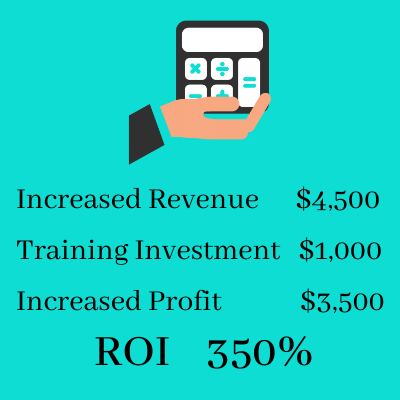Want a 350% ROI?

I’ve got the investment for you! And, it’s not too good to be true. It really does yield a 350% ROI! And, it’s legal!
This investment is training!! On average, one dollar invested in training increases the bottom line by $4.53, yielding a 353% return.
What is the catch? To yield a strong return the training has to be relevant to your organization’s needs. It must meet 3 criteria:
- result in trainees learning new knowledge and developing new skills,
- have job impact, be relevant and be used at work after training,
- improve the organization’s bottom line.
What is limiting your bottom line? Which of your current challenges would be reduced if your employees interacted, behaved, or worked differently? Training could be the solution.
Many of the 385,000 open job positions in manufacturing are paying new hires $40,000 per year. These positions remain unfilled because job seekers lack skills in manufacturing fundamentals or robotics. Vocational schools and community colleges offer such training but enrolment is low.
Many small businesses are always short-handed. Their staff are getting burned out. Managers are reluctant to hire job applicants who are weak in workplace fundamentals. Personal Leadership Effectiveness™ training is available to help individuals become more reliable, positive, and productive so they add value at work.
Most people are doing the best job they can with their current knowledge and skills, but due to their lack of know-how they may be achieving less than half of their potential. Their supervisors are too busy with other responsibilities to coach them. The HR department is prioritizing administration above training. The company could increase its bottom line by $3,500 for every $1,000 invested in relevant training.
90% of managers lack effective leadership skills. Most staff who leave a company do so to escape one of these bad managers. Effective management training leads to enhanced employee engagement and can increase the organization’s bottom line by 50% or more. The Conversational Management™ program can generate such an impact.
Would you like to improve your company’s bottom line by meeting the needs of more customers and helping all employees add value? Then, first, it’s time to identify the gaps in staff knowledge, skills, and behaviors. And, second, invest in training that will produce win/win results for staff members and the organization.
Contact Cathie Leimbach to discuss needs assessment strategies and effective ways to enhance leadership, team player, and soft skills competence within your organization so employees are equipped to achieve profit and impact goals.

